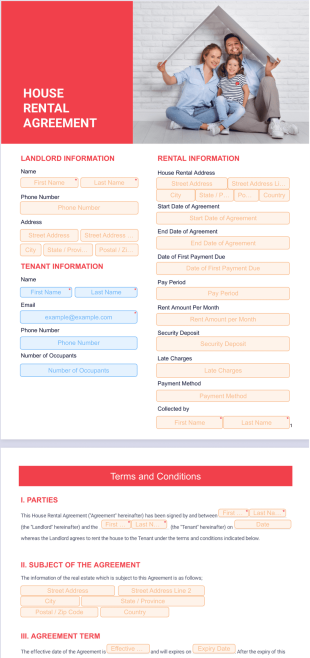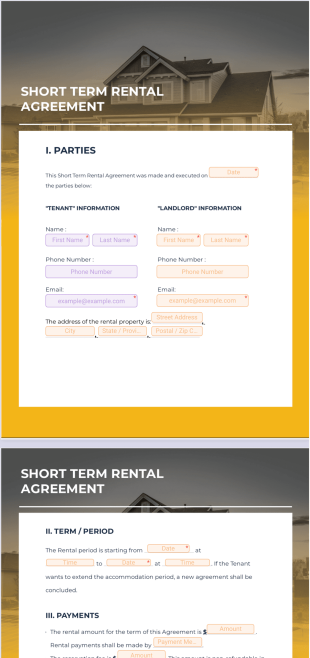Simple One Page Lease Agreement FAQs
1) What type of property are you renting?
The clauses and terms of a simple one-page lease agreement will vary depending on the type of property being rented. Lease agreements for a house will include different details from those of a townhouse or apartment. The property’s neighborhood might also determine these details.
Not only does the size of the property determine what clauses to include in your lease but the amenities, utilities, and furnishings do as well. Be sure to tailor your lease agreement to fit the exact needs of your property before signing and sending it to a tenant.
2) How many pages are in a typical lease agreement?
There are many different property types, so there’s no typical length for a lease agreement. A lease agreement’s length depends on the number of clauses and rental provisions a landlord includes as well as how detailed they choose to be.
Standard lease agreements will typically contain clauses covering the following information:
- Pet policy
- Property use restrictions
- Occupancy limits
- Subletting conditions
- Rules for guest stays and extended absences
- Property condition
While one-page rental agreements are straightforward, a more complex lease agreement may be over a dozen pages long. A longer lease agreement leaves room for more comprehensive legal language, but it may also intimidate tenants and make them wary of unfair rental provisions. By using a simple one-page lease agreement, you’ll communicate the most important information without confusing your tenants.
3) What’s the difference between a simple one-page lease agreement and a residential agreement?
The key difference between a simple one-page lease agreement and a residential agreement is the length. Residential agreements will have varying lengths. Depending on the landlord or property details, a residential agreement may require more clauses and provisions than a one-page lease can include.
4) Who needs a simple one-page lease agreement?
Simple one-page lease agreements are perfect for landlords who want to communicate quickly and effectively with their tenants. Long, legalese-heavy leases are often a burden for tenants. The longer the lease, the higher the likelihood of tenants missing clauses or not even reading the entire agreement.
These circumstances often lead to misunderstandings between tenants and landlords. Keeping your lease agreement short makes it easier for your tenants to understand all vital information, and it leaves your tenants feeling more comfortable and even empowered to sign.
5) Can I use a simple one-page lease agreement to rent a room in a house?
Although a simple one-page lease agreement is acceptable for renting a room in a house to a tenant, it’s not recommended.
When you choose to rent out a room in your home, you agree to share much of your own space with this person. To protect your tenant’s privacy as well as yours, you need to define boundaries through special provisions in the lease, particularly regarding your personal property.
A simple one-page lease agreement, while helpful, isn’t as comprehensive. Gaps in your agreement will leave you vulnerable to potential issues.
If you decide to rent out a room, all the clauses you need to consider including in an agreement likely won’t fit on one page. A single page of text may not allow you to include language that covers multiple provisions, such as the following:
- House rules
- Privacy agreements
- A description of the room and the overall property
- Details about sharing amenities
- Guidelines on various living arrangements, including visitors, parking, noise, curfew, chores, and more
These clauses will protect against potentially troublesome tenants and will secure your legal rights as a landlord and property owner.
6) What should be in a one-page lease agreement?
An effective one-page lease agreement presents tenants with everything they need to know, without frills or complex language, to have a successful tenancy. When creating a one-page lease agreement, include sections covering the following:
- Involved parties
- Property details
- Lease terms, such as length, type, monthly rent, deposit
- Conditions of property use
- Details about utilities
- Included furnishings
- Repair and damages policy
- Termination conditions
- Renewal conditions
- Signature and date
Besides clear language, the one-page lease agreement also needs to be visually clear with a design that ensures maximum comprehension. Try customizing our simple one-page lease agreement template to fit your needs.
7) How do you fill out a one-page lease agreement?
Once you’ve drafted, edited, and customized your lease agreement to fit your property’s requirements, it’s time to fill it out and sign it. Remember, your tenants have no responsibility to honor provisions that aren’t in a lease. Double-check that you’ve included the following:
- Address
- Lease length
- Monthly rent
- Deposit amount
- Amenities and furnishings
You can print the agreement to sign it in person with your tenants. Or you can choose an online signing platform that accepts e-signatures. If you find that a one-page lease agreement template doesn’t meet your needs, consider using another type of lease agreement template.






